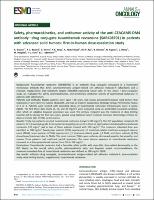Safety, pharmacokinetics, and antitumor activity of the anti-CEACAM5-DM4 antibody–drug conjugate tusamitamab ravtansine (SAR408701) in patients with advanced solid tumors: first-in-human dose-escalation study
Author
Date
2022-04Permanent link
https://hdl.handle.net/11351/8032DOI
10.1016/j.annonc.2021.12.012
ISSN
0923-7534
WOS
000820214100008
PMID
35026412
Abstract
Tusamitamab ravtansine (SAR408701) is an antibody–drug conjugate composed of a humanized monoclonal antibody that binds carcinoembryonic antigen-related cell adhesion molecule-5 (CEACAM5) and a cytotoxic maytansinoid that selectively targets CEACAM5-expressing tumor cells. In this phase I dose-escalation study, we evaluated the safety, pharmacokinetics, and preliminary antitumor activity of tusamitamab ravtansine in patients with solid tumors.
Patients and methods
Eligible patients were aged ≥18 years, had locally advanced/metastatic solid tumors that expressed or were likely to express CEACAM5, and had an Eastern Cooperative Oncology Group Performance Status of 0 or 1. Patients were treated with ascending doses of tusamitamab ravtansine intravenously every 2 weeks (Q2W). The first three dose levels (5, 10, and 20 mg/m2) were evaluated using an accelerated escalation protocol, after which an adaptive Bayesian procedure was used. The primary endpoint was the incidence of dose-limiting toxicities (DLTs) during the first two cycles, graded using National Cancer Institute Common Terminology Criteria for Adverse Events (NCI CTCAE) v4.03 criteria.
Results
Thirty-one patients received tusamitamab ravtansine (range 5-150 mg/m2). The DLT population comprised 28 patients; DLTs (reversible grade 3 microcystic keratopathy) occurred in three of eight patients treated with tusamitamab ravtansine 120 mg/m2 and in two of three patients treated with 150 mg/m2. The maximum tolerated dose was identified as 100 mg/m2. Twenty-two patients (71%) experienced ≥1 treatment-related treatment-emergent adverse event (TEAE), seven patients (22.6%) experienced ≥1 treatment-related grade ≥3 TEAE, and three patients (9.7%) discontinued treatment due to TEAEs. The most common TEAEs were asthenia, decreased appetite, keratopathy, and nausea. Three patients had confirmed partial responses. The mean plasma exposure of tusamitamab ravtansine increased in a dose-proportional manner from 10 to 150 mg/m2.
Conclusions
Tusamitamab ravtansine had a favorable safety profile with reversible, dose-related keratopathy as the DLT. Based on the overall safety profile, pharmacokinetic data, and Bayesian model recommendations, the maximum tolerated dose of tusamitamab ravtansine was defined as 100 mg/m2 Q2W.
Keywords
Antibody–drug conjugate; Dose-escalation study; Tusamitamab ravtansineBibliographic citation
Gazzah A, Bedard PL, Hierro C, Kang YK, Abdul Razak A, Ryu MH, et al. Safety, pharmacokinetics, and antitumor activity of the anti-CEACAM5-DM4 antibody–drug conjugate tusamitamab ravtansine (SAR408701) in patients with advanced solid tumors: first-in-human dose-escalation study. Ann Oncol. 2022 Apr;33(4):416–25.
Audience
Professionals
This item appears in following collections
- HVH - Articles científics [4476]
- VHIO - Articles científics [1250]
The following license files are associated with this item:

 Private area
Private area Contact Us
Contact Us








